 Leading Blog | Posts by Month |
 Leading Blog | Posts by Month |
11.30.22

LeadershipNow 140: November 2022 Compilation
See more on
Posted by Michael McKinney at 07:04 AM
11.29.22

Why Managers Matter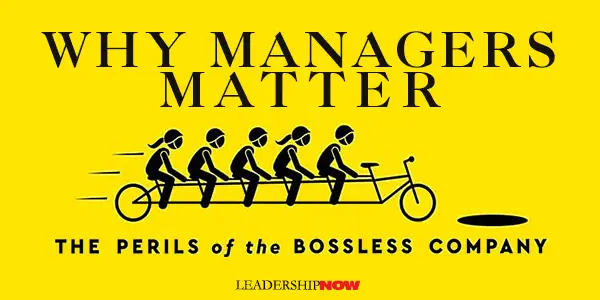
ONE OF the most important books you’ll read this year is Why Managers Matter: The Perils of the Bossless Company by Nicolai Foss and Peter Klein. Max DePree wrote that the first responsibility of a leader is to define reality. That’s what you will find here—a dose of reality. It is popular today to talk about the bossless organization and the death of hierarchy. Not everyone is fooled by the hype. The purpose of the book is to dispel the notion that hierarchy and managers are on their way out. Any student of organizational theory knows that this is a reoccurring issue making it both contemporary and relevant. Hierarchies not only work better than the alternatives most of the time but they are also aligned with our basic human nature, which, more than anything, explains why they persist. Of course, there is a great variation among hierarchies. Some people do them well, and some don’t. “Authority and hierarchy—rightly exercised—are useful and necessary for companies to thrive.” The hierarchically organized company actually emerged during a period in world history notable for radical changes in technology, a sweeping expansion of global trade, and increases in public education—namely, the period from the middle of the nineteenth century until World War I. Growth drives hierarchy. Hierarchies help to deal efficiently with complexity. And in times of great uncertainty, we need managers. “It is when something extraordinary happens that we need managers the most.” A well-structured hierarchy helps firms buffer unanticipated shocks. The author’s close examination of bossless organizations reveals that they are perhaps flatter but not really bossless. Even the outliers like Gore, Valve, Zappos, Oticon, and Semco, are not genuinely bossless organizations. There is a place for these leaner, flatter structures. Bosslessness, at best, works for a handful of companies operating under special conditions, such as small companies that carry out simple tasks—like the food processor Morning Star. Decentralized structures tend to be most effective in particular circumstances, such as where groups and tasks can be broken down into smaller independent units. Siloing, turf wars, and the like are more easily avoided when teams are organized around projects—say, building a bridge or developing a specific piece o software—rather than on the business functions such as marketing, sales, or finance. Hierarchy helps solve the universal problems of coordination and cooperation. “Coordination means figuring out what should be done, by whom, when, how, and in what quantities.” Coordination defines responsibilities and how my job relates to yours. It is about how an organization brings people together. “Cooperation is about getting them to do it, even when doing so is not in everyone’s self-interest.” These management tasks don’t just go away just because we might decide to go Bossless. “Bosses matter, not just as figureheads but as designers, organizers, encouragers, enforcers.” Decentralization and delegation are tools that managers can use when the conditions are right. They are not a unique feater of the bossless organization. It is possible to delayer, cut management roles, and give workers more discretion, though doing so does not result, of course, in a bossless company. As we have seen, such organizations normally have very powerful bosses, cliques, and other sources of authority—and even the most bossless companies have bosses who set them up and make sure the model is working. Although the authors would agree the management of people needs to change, that is not the point of the book. They cover how hierarchies have changed and how the people in them need to think about their work. We know how to manage people. We just don’t do it. And that is the key. We keep looking for some magic bullet as we look around at who or what to blame. Hierarchy is not the problem. Managers are not the problem. We are. When things aren’t working right, it is expedient to blame something other than ourselves. Inequities, engagement, micromanagement, and the like are not the fault of the hierarchy. It is the fault of people in the hierarchy—leaders, managers, and employees alike. The real value of this book to me is that it helps to take hierarchy and managers off the table so we can deal effectively with the organizational issues of the day. We can get on with the personal inner work necessary to get to where we need to be. There are no universally “best” solutions to organizational problems, only trade-offs that depend on the contingencies facing the company. Identifying and acting upon those trade-offs—not decentralizing everything, everywhere—is the key to successful leadership. 
Posted by Michael McKinney at 12:31 PM
11.24.22

Leading Thoughts for November 24, 2022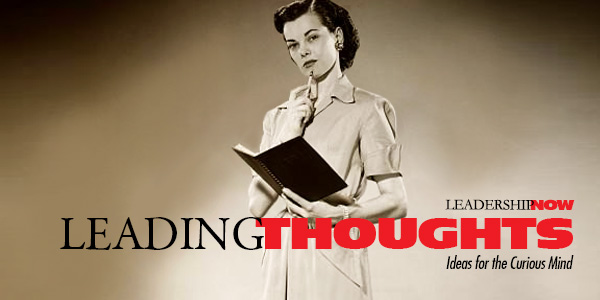
IDEAS shared have the power to expand perspectives, change thinking, and move lives. Here are two ideas for the curious mind to engage with: Ryan Hawk on the quality of gratitude that you find in transformational relationships and people: “They compliment people behind their backs. When you’re talking with these types of people, they are constantly shining a light on the goodness of others. When something goes well in their life, they are quick to point out how it couldn’t have been done without the great work of other people.” Source: The Pursuit of Excellence: The Uncommon Behaviors of the World’s Most Productive Achievers Jonathan Sacks on the benefits of gratitude: “When individuals focus on and express thankfulness, they experience more positive emotions. Gratitude encourages the savoring of positive experiences. It bolsters feelings of self-worth. It helps people cope with stress. It inhibits invidious comparisons with others. It encourages moral behavior—grateful people are more likely to help others. It tends to dissipate negative emotions such as anger. And it counteracts the hedonic treadmill. Gratitude is the opposite of the mindset of the market-led, consumer society. It is about satisfaction with what we have, not hunger for what we do not have.” Source: Morality: Restoring the Common Good in Divided Times Look for these ideas every Thursday on the Leading Blog. Find more ideas on the LeadingThoughts index.
Posted by Michael McKinney at 06:51 AM
11.22.22

Executive Presence: Why it Matters. How to Get it.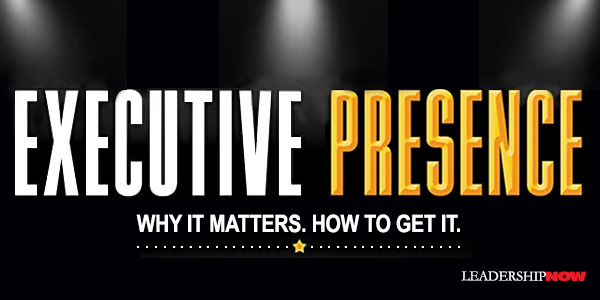
HOW IMPORTANT is executive presence? “No one can realize their full potential without executive presence,” says Joel Garfinkle. Seventy-eight percent of business leaders state that a low level of executive presence paralyzes career advancement. Executive presence is another way of saying leadership presence and should be a part of our personal leadership development agenda. “Practicing the skills that support a strong executive presence will lay the groundwork for becoming the best leader possible.” Executive Presence by Joel Garfinkle will show you the right qualities to be practicing and the specific behaviors that will highlight your strengths and increase your contribution as a leader. It is possible for the self-absorbed person to come across with the appearance of executive presence, but as Abraham Lincoln is often credited as saying, “You can fool all the people some of the time and some of the people all the time, but you cannot fool all the people all the time.” Garfinkle says: They can talk a good game and may even rise up through the ranks because some leaders perceive their arrogance as confidence. However, they lack essential qualities of executive presence that will make them truly a great leader, and most experienced leaders will see through them. Great leaders are committed to nurturing others, leveraging all of their executive presence qualities for the good of the team rather than just personal gain. And this is really what the endgame of executive presence is. Your confidence is people-centered. Executive presence is about lifting other people up, not dominating them. So, as you practice these behaviors, it is helpful to understand the why of building executive presence. Garfinkle has created the 3x3 Executive Presence Model—as shown below—to guide you in developing your executive presence. It sets up three domains, each containing three core competencies. “To cultivate executive presence, you need to look closely at how you show up at work, how you speak, and how you make decisions.”
What holds us back more than anything else is self-doubt. It is our internal beliefs that limit us. By examining the 3x3 Model, we can more easily see what internal thinking may be controlling the behaviors that hold us back from being as effective as we could be. The competencies that have been identified in the Model need to be in balance. “When a person has a great deal of one quality but not complementary ones, it can undermine their overall executive presence.” For instance, a leader who comes across as always in command but who hasn’t cultivated charisma probably won’t seem approachable. Such people tend to intimidate others and seem domineering, which negatively affects their ability to lead. Similarly, leaders who are extremely decisive but can’t vocalize the reason behind their decisions will have trouble gaining buy-in. To have executive presence, you need to develop the overall package, not just a few select characteristics. Many of us have some of these core competencies, but not all. The Model will help us to find the balance we need by filling in the gaps. What is particularly useful are the chapters discussing in depth the specific behaviors associated with each of the nine core competencies. There are questions, evaluations, and exercises throughout the book to guide you step-by-step and keep you on the right path. 
Posted by Michael McKinney at 08:01 AM
11.18.22

Tears from Bordeaux: Leadership Lessons from a Failure to Win Gold
HOW COULD I be spending 10 days in Bordeaux, the premium wine district in France, yet feel unhappy? I had no work to do, was surrounded by beautiful scenery, and found amazing French cuisine around every corner. Yet, there I was, feeling sorry for myself. Was I somehow looking at circumstances the wrong way? Sure, I was honored to be representing Canada at the Senior World Water Ski Championships. But when I didn’t ski as well as expected, I suddenly lost my equilibrium. Friends and family tried to cheer me up, but a pat on the back from well-meaning supporters didn’t help much, especially when my expectations were linked to either a gold, silver, or bronze medal. Most would expect a rational, logical response to this situation from a 67-year-old who had for many years been CEO of a major construction and real estate enterprise. Yet I was letting my emotions take over. I didn’t throw my ski or swear a blue streak, but I found it hard to enjoy the beauty and bounty around me. Where did these feelings of despair come from? Shouldn’t I be able to lift myself out of the pit I’d fallen into? Couldn’t I replace the feelings of discouragement with different thoughts so I could I be happy in France in spite of how I had skied? Could cultivating more emotional intelligence have helped? I believe so. Surprisingly, when we become more curious, more patient, and more humble, we can cope with challenges and disappointments much more effectively as leaders — and competitive athletes. Permit me to explain: Curiosity: In essence, curiosity is a hunger to know more and have a greater understanding. It’s a drive to discover and to expand our horizons. Instead of focusing on what I hadn’t accomplished, I would have been wise to remain curious. I could have asked myself, “What can I learn from this? How can I get better?” Had I done this, I could have remained grounded and grateful rather than so self-focused and critical of my performance. Many executives, early in their careers, possess unbridled curiosity. But as time goes on and they achieve greater success, they allow their curiosity to fall to the wayside and therefore constrict their potential to learn. This is true in both business and in sports. As the great former UCLA basketball coach John Wooden said, “A leader who is through learning is through.” Humility: I arrived in France full of optimism, believing I had a good chance of finishing on the podium in my division. Although belief in our own abilities is important, confidence is overrated. What’s more, relying on ourselves puts a lot of weight squarely on our own shoulders. This burden can weigh us down and prevent us from performing at our best. In contrast, humility helps us to achieve more than we ever thought possible. Rather than trying to cultivate confidence, we should focus on cultivating humility. Instead of believing or trusting in ourselves, we’d be wise to trust in our training. As most athletes will admit, confidence is hard to conjure up and to sustain. However, putting our faith in the process can be liberating. Doing so takes the pressure off our performance and puts it where it belongs — on the process. With this approach, we can do the hard work required to hone our craft, and then when it’s time to perform we can be more relaxed and trust that we’ve put in the work required to excel. Former New York Yankee superstar Alex Rodriguez famously quipped that he was paid as a baseball player “to get hits.” However, instead of trying to get hits, he focused on trying to get four good “at-bats” each game. If he could do that, he said, “the hits would always come.” Humility begins with introspection and an honest appraisal of oneself. Just like looking in the mirror, humility gives us an accurate picture of ourselves. Patience: Warren Buffet recently noted, “The key to everything is patience. You get the chicken by hatching the egg, not by smashing it.” After my disappointing result in France, I felt like quitting as a competitive skier. Thankfully, my wife talked some sense into me, encouraging me to remember how far I’d come. She re-focused my attention on preparing for the next World Championships in two years. Patience comes from the Latin word “Pati,” which means to suffer. Therefore, patience can be understood as a willingness to suffer (or tolerate) delay without getting all bent out of shape. Raphael Nadal, the legendary tennis star with more Grand Slam victories than any male tennis player in history, emphasizes that in order to win, he needs to be “willing to suffer.” We can all learn from his example. Yet, in a culture geared to rapid or instantaneous responses to almost everything, we’re not accustomed to being patient. In our world, waiting is rarely required, and that’s made us unwilling to exercise patience. Rather than accepting that many circumstances are beyond our control, we plan our days and our lives around the mistaken expectation that traffic always runs smoothly, parking spots are always available, and flights are always on time. It would be nice if those expectations were met, but the reality is usually very different. We’ll continue to be frustrated and impatient unless we come to accept that life doesn’t always unfold as we hoped or planned. To retain or recover our emotional bearings when things don’t go as planned, cultivating our emotional intelligence and working to become more curious, more humble, and more patient will improve our attitude. These tips will help leaders and athletes alike to develop these soft skills. Cultivating Curiosity:
Developing Humility:
Learning Patience:
My trip to Bordeaux was a major disappointment. But it wasn’t just because I didn’t win a medal. It was disappointing because I’d been looking at life the wrong way. Instead of being grateful for the opportunity and enjoying the experience, I’d been caught up in the quest to win. In hindsight, I missed out on what could have been a great vacation. The next time, in addition to taking my ski equipment, I plan to also bring along curiosity, humility, and patience. Not only do I think they’ll be good traveling companions, they might also help me to perform better.  
Posted by Michael McKinney at 08:00 AM
11.17.22

Leading Thoughts for November 17, 2022
IDEAS shared have the power to expand perspectives, change thinking, and move lives. Here are two ideas for the curious mind to engage with: Computer scientist and venture capitalist Paul Graham on the tendency to go with the crowd: “Let’s start with a test: Do you have any opinions that you would be reluctant to express in front of a group of your peers? Source: Hackers & Painters: Big Ideas from the Computer Age Consultant Anish Batlaw on building a pipeline of talent inside the company: “Companies will need systematic programs for identifying people inside the company and grooming them so they are ready when important opportunities open. And this talent cannot be a carbon copy of the leaders who came before. In the knowledge economy impacting all areas of our lives, business leaders need a broader range of skills than previously required to deliver multiples in value creation. In the globally networked world, organizations must collaborate more than ever, internally as with other organizations and partners, across boundaries, and across disciplines. Future generations of leaders must be more agile and comfortable with ambiguity and be able to anticipate and build capabilities ahead of the curve. They are going to need to learn at a much faster pace than ever before and be the drivers of innovation and change.” Source: Talent: The Market Cap Multiplier Look for these ideas every Thursday on the Leading Blog. Find more ideas on the LeadingThoughts index.
Posted by Michael McKinney at 06:47 AM
11.14.22

The President’s Man: Insights into the Nixon White House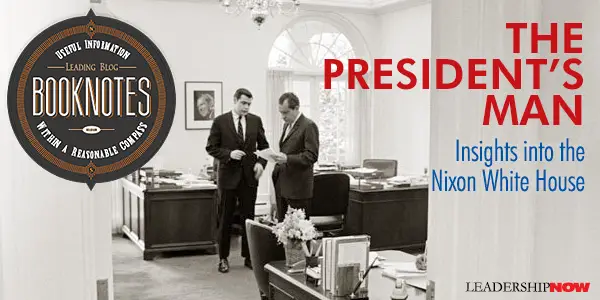
ON the 50th anniversary of the Watergate break-in, we have a more nuanced account of the Nixon White House in The President’s Man, from the perspective of his personal aide Dwight Chapman. To the curious and open-minded, his perspective is illuminating. Time always provides depth. Chapman says his life changed for the better and forever when he was introduced to Bob Haldeman on the campaign for Nixon’s 1962 run for California governor. As they say, the rest is history. Haldeman, an “unbelievably intelligent” and an “unfailing decent man,” became his mentor and closest friend. Over time, he learned Nixon’s needs and habits and became a trusted aide and Deputy Assistant. Nixon once advised him, “Dwight, as you go through life, just always remember the key thing is keeping your learning curve vertical.” Never stop learning. Here are some of the insights from the memoir: UNDERSTANDING NIXON ❧ Sometimes out of anger or his own frustration or whatever his emotion, [Nixon] just spouted off. He would say things he didn’t really mean. Some historians have overlooked that very human trait—that he was subject to the same passions and shortcomings as the rest of us. ❧ Great damage was done to President Nixon’s reputation by his inclination to issue knee-jerk orders or demands that he really didn’t expect to be carried out. These impulsive reactions, when taped and then replayed by the media, served to undermine his character and created a false impression of the man I knew. ❧ Nixon always cared about how people were treated. He knew that little things mattered. The bigger and more prominent the person was, the more the little things they did mattered to those they encountered. ❧ [Nixon] was a reader, especially about the great men of both recent and distant history. ❧ Meeting leaders in Europe and Asia, he learned from those men how they “think.” He loved talking about thinking. He asked those leaders, personally, how they thought, why they governed the way they did. Nixon was intellectually curious. He was a seeker of the “hows” of leading, of political life. KISSINGER ❧ Some former colleagues were critical of Kissinger’s maneuvering and what they saw as his “propensity to eclipse” the president. I never saw it that way. Nixon towered over Kissinger, in my view. I dismissed Kissinger’s need for gratification as being just that: a need for gratification. I never saw him as anti-Nixon. ❧ The two of them [Nixon and Kissinger] had tremendous chemistry. Both were extremely smart, knowledgeable, and creative. They were both strategic thinkers. They fed off each other’s minds. They were able to talk to each other on a very sophisticated level. Nix on would develop his strategy and henry would get on an airplane and fly off to negotiate. I have always described their relationship as Nixon being the architect and Henry being the builder. That was certainly true where Vietnam was concerned. DECISION-MAKING ❧ Richard Nixon did not make impulsive or emotional decisions. Everything he did was considered and weighed. ❧ The president wanted Haldeman to put in place a system that maximized the efficient exchange of ideas; put a focus on providing the information necessary for informed and wise decision-making; and provided for the discipline necessary to make it all work. ❧ He would review options incessantly, looping back over subjects previously covered, until, in his mind he had finally reached a decision or point of view with which he was comfortable. If a decision had to be made quickly, he could make it quickly. ❧ Nixon chose to surround himself with intelligent people who he knew wouldn’t necessarily agree with him on everything. He wanted to work with people who would challenge him intellectually. ❧ What Nixon did so well, usually, was move people toward a consensus. This was great when there was no time pressure. He was a very perceptive man and had the ability to get things done. When necessary, he would pit those people against each other, in an intellectually competitive way, using them as a way to forge a solution. PRESS ❧ I think his anticipation of the continual negative attacks by the press became too ingrained in his psyche and created complicated and unnecessary mental roadblocks for him. ❧ The press did everything possible to reinforce the negative image it had helped create, too often misrepresenting details and facts. TAPES ❧ The abuse of power tapes are 5 to 7 percent of the total. How many people would want that grayer side of their illustrious life measured by the 7 percent where they may have done or said inappropriate things? VIETNAM ❧ Without the protestors knowing, they were reinforcing the enemy’s determination not to end the war short of complete U.S. capitulation, and therefore prolonging it. North Vietnam premier Pham Van Dong’s message of support to protestors before the October 15 moratorium was a nail in the coffin of Nixon’s plan to end the war by the end of 1969. The protestors forced Nixon to back off his threats to use force to end the war if North Vietnam wasn’t a productive partner in negotiations. ❧ It is important to note that black bag operations had been executed in previous administrations and were approved by, even run by, the FBI. In past administrations it was the FBI that conducted black bag operations under the cover of national interests. It was the Nixon White House that brought these operations in-house in order to find and plug leaks. CHINA ❧ Nixon said, “We are going to China because in fifty years we will be adversaries and we must be able to talk to one another.” WATERGATE ❧ One of the reasons the White House response was lacking is that the president had no idea of exactly what had happened, or why it had happened. He was treating it like a public relations problem. ❧ John Mitchell said, “The public generally does not understand what Watergate was all about and never will. Americans believe that everything that happened during the pertinent time was wrong because [they were] told that such was the case and never thought it out.” The result was that “the country lost a very competent president during a time when it needed him, particularly in the field of foreign affairs.” ❧ The main lesson to be learned from Watergate, wrote Haldeman, “would seem to be the basic point that any problem must be dealt with openly and realistically—not put aside or covered up.” ❧ There is no question that there was a real crime and that it was being covered up. However, people in positions of power were not thinking criminally. The were thinking, as Haldeman clearly believed, “containment,” political containment. Richard Nixon responded instinctively based on everything that had happened to him in his political career. His first thought must have been, Here they come. They’re coming after me again. This wasn’t paranoia. They really had come after him in the past and they were coming after him again. But rather than putting that feeling aside and focusing on how to best handle the situation, he made the worst possible decision. He started fighting back. Worse, he did so without knowing the facts. The president was being misled and wrongly advised by Joh Dean. His trusted counsel was providing the president with incomplete and often misleading information in an apparent effort to save himself—not to faithfully advise the president. 
Posted by Michael McKinney at 07:34 AM
11.11.22

How MIT’s Unique Culture Created a Thriving Entrepreneurial Community … and You Can Too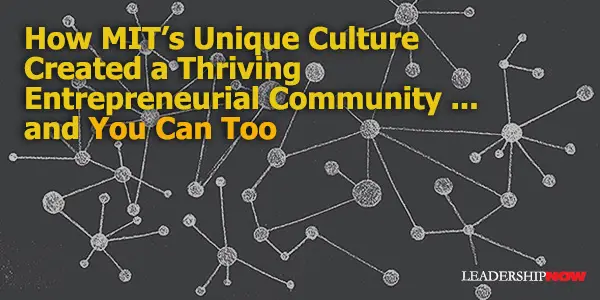
AS OF 2015, Massachusetts Institute of Technology (MIT) alums have founded over 30,000 active companies that employed 4.6 million people. And together, they had revenues of 1.9 trillion dollars. In From the Basement to the Dome, Jean-Jacques Degroof explains why MIT has become such an entrepreneurial hotbed and what we might learn from it to improve our efforts. Recreating the MIT entrepreneurial ecosystem is not easy. It is a culture that has developed over many years and not from deliberate policy by the Institute. “Entrepreneurship at MIT sparked and began to thrive as the result of the isolated initiatives of alumni, students, and individual faculty and staff members, primarily in the realm of extracurricular activities, especially in the early days.” We may not be able to recreate the secret sauce, but there are lessons and principles that we can take away and apply to our institutions and organizations. First, let’s look at some of the history of the MIT entrepreneurial movement. Karl Compton was president of MIT in the 30s and realized that the “launch of new venture commercializing emerging technologies requires those companies to have access to their own source of capital. Thus, the intuition behind venture capital was born.” And so on “June 6, 1946, the American Research and Development Corporation (ARD) was incorporated. It was the first institutional venture capital firm. Over the years, ARD invested in 120 companies and also spun off other venture capital firms, effectively launching the venture capital industry and the venture capital-backed firm. ARD’s most successful investment was the computer firm Digital Equipment Corporation.” MIT professor Leo Beranek—of Bolt Beranek and Newman fame—said that “One of the reasons that MIT has been so important in the world has been that they were willing to encourage their professors to start businesses. . . . And of course, MIT had the proper kind of teaching so that the students got to realize that maybe one of the best things they can do is to invent something and start a company.” In 1961 MIT offered its first-ever entrepreneurship course: New Enterprises. It would remain the only graduate course in entrepreneurship until Corporate Entrepreneurship was launched in 1972. “This was a sign of limited interest on the part of the students and of the low status of entrepreneurship in academic circles.” The approach has been practical. “The strong commitment to learning by doing and to solving real problems has endured to this day and has constituted a fertile ground for the faculty, students, and alumni to develop an interest in entrepreneurship in recent decades.” In 1988 the MIT Entrepreneurs Club was launched to encourage entrepreneurship and foster critical networking. It was formed because “at MIT back in the 1980s, there were lots of people with interesting ideas, but few opportunities for people to meet to discuss them or to learn how to turn the ideas into companies, and there was little interaction between the people developing technologies in the School of Engineering and those with expertise in business at the Sloan School. The club was conceived as a way to meet that need and to bridge silos that existed between the management and the engineering side of the campus.” It was also open to alumni. Former alumni had said that “entrepreneurship is a form of intellectual immigration, consisting of leaving one’s comfort zone and going somewhere where you cannot take anything for granted.” And “Entrepreneurs create an organization that didn’t exist before. They have a scarce amount of resources with which to do that. They are the underdog. Entrepreneurs, by definition, try to challenge incumbents.” As entrepreneurship requires thinking outside the box, it requires thinking across disciplines and domains. “One of the few reliable rules drawn from research in entrepreneurship is that diverse teams of start-up founders perform better on a range of outcomes. A general prerequisite of most MIT entrepreneurial contests or accelerators, for instance, is that participants form mixed teams of scientists and engineers with management students.” These projects often result from fortuitous encounters and informal relationships built across these porous spaces. Working on side projects is a good way to find cofounders. “When you build stuff for fun, it gives you the highest likelihood of meeting similarity-minded people. And when you’ve already worked with people before on past projects, there’s much less risk and a higher chance of success later on.” The Martin Trust Center for MIT Entrepreneurship “sees its mission, first and foremost, as educational. In addition to teaching students how to launch businesses, its objective is to teach students how to develop an entrepreneurial mindset. Thus, it focuses on instilling an entrepreneurial skillset and mindset within students, as opposed to churning out start-ups.” The Trust Center’s motto: “We don’t build start-ups. We build entrepreneurs.” Entrepreneurial thinking can be taught. “MIT clearly stands on the side of those who believe entrepreneurship can—and should!—be taught as a key engine to feed innovation.” There is a strong belief at MIT that entrepreneurship is a team sport. It is based on the evidence that teams of founders tend to perform better than individual founders and that complementary teams tend to do better than homogeneous teams. Following on the heels of the I-Teams class, nowadays, most teams in entrepreneurship-related courses or contests are required to be composed of a mix of engineering or science students with management students. What can we learn from this? As we have seen, openness to bottom-up initiatives and decision-making is a well-ingrained, bottom-up organizational dynamic at MIT. Learning by doing and problem-solving—taking what we have learned out into the real world to test for relevance and to iterate on our ideas. Entrepreneurship is not a science but a profession and a way of looking at the world. Experimenting and tolerance to failure. Entrepreneurship fits perfectly into such an approach because it is also a process of experimentation and trial and error. MIT’s tradition of a multidisciplinary approach to problem-solving goes a long way to enabling novel solutions based on a unique combination of disciplines. Too often, we see entrepreneurial programs operating independently of engineering and the sciences. MIT’s motto, mens et manus (“mind and hand” in Latin), and its logo — which features the scholar and the craftsman in parallel positions — are about using what we learn to make a positive impact on the world. Embracing those who think differently from you. The identity of being an outsider is alive and well at MIT. There is pride in and respect for the rebels, the disruptors, the upstarts, and those pursuing unconventional solutions. 
Posted by Michael McKinney at 07:46 AM
11.10.22

Leading Thoughts for November 10, 2022
IDEAS shared have the power to expand perspectives, change thinking, and move lives. Here are two ideas for the curious mind to engage with: David Abshire on trust: “Trust, in its fullest sense, extends beyond simply having great confidence in a person, of faith that a task will be performed. Trust manifests itself when one becomes committed to the protection and care of someone else—he is entrusted to that person who holds his faith in trust.” Source: Speech, “Trust and General Hal Moore,” June 11, 2006
Peter Drucker on the responsibility dictated by choice: “In a few hundred years, when the history of our time will be written from a long-term perspective, it is likely that the most important event historians will see is not technology, not the Internet, not e-commerce. It is an unprecedented change in the human condition. For the first time—literally—substantial and rapidly growing numbers of people have choices. For the first time, they will have to manage themselves. And society is totally unprepared for it.” Source: Leader to Leader, Spring 2000, “Managing Knowledge Means Managing Oneself” Look for these ideas every Thursday on the Leading Blog. Find more ideas on the LeadingThoughts index.
Posted by Michael McKinney at 06:57 AM
11.07.22

A Man of Iron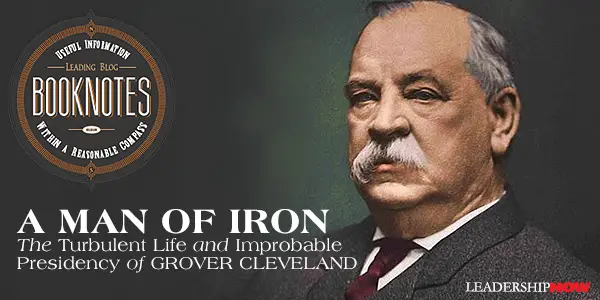
WHEN reading A Man of Iron by Troy Senik that reassesses the life and the improbable presidency of Grover Cleveland, you can’t help but reevaluate your notion of what makes a great leader. It is refreshing to read of a public figure willing to follow principle regardless of the political consequences. At the age of forty-four, the only elected office Grover Cleveland had ever held was sheriff of Erie County, New York—a role he had relinquished nearly a decade earlier, returning to a rather uneventful life as a workaholic bachelor lawyer. In the next four years, he would become, in rapid succession, the mayor of Buffalo, the governor of New York, and the twenty-second president of the United States. Four years later, he would win the popular vote but nevertheless lose the presidency. And in another four, he’d become the first—and, to date, only—president to be returned to office after having been previously turned out. ❧ The trick to Grover Cleveland was that he could only surprise you if you hadn’t been paying attention. The man in office was precisely the man who had been on the ballot, who was precisely the man who toiled long into the night behind his law desk, who was precisely the kid who showed up at the Eire Canal at 4 a.m. to get a jump on his competition. To the extent he was profound, it was because he was a simple, straight-forward man in a Janus-faced profession. To the extent his conduct was shocking, it was only because he had a habit of doing exactly what he had said he would do. ❧ Scan Grover Cleveland’s entire political career and there is but one principle—always articulated, if not always constantly applied—that shaped all others: government exists to protect the welfare of the people as a whole. And any preference government shows to one individual over another is to be regarded as per se suspicious. ❧ If Grover Cleveland wasn’t a political genius he had an incredible knack for stumbling into situations that made him look like one. ❧ That Cleveland was such a short remove from the unremarkable life of a Buffalo lawyer—combined with the fact that his no-frills personality seemed impenetrable by changes in status—went a long way to explaining the modesty with which he approached the presidential transition. He declined President Arthur’s offer to stay at the White House prior to swearing in, choosing a local hotel instead. He even paid for his own train fare for the journey from Albany to Washington, thinking it unbefitting a president to accept any benefits on account of his station. ❧ On a walk with a Buffalo acquaintance shortly after the election, he declared, “Henceforth, I must have no friends.” The American presidency is often lamented as the loneliest job in the world. For Grover Cleveland that was a necessity to be embraced rather than a tragedy to be endured. ❧ It would be the case from their wedding day forward that Frances—young, big-hearted, and beautiful—was the member of the Cleveland family who truly captivated the public. Not quite twenty-two years old, she had become the youngest First Lady in American history. The effect she had on Washington would be unrivaled until Jacqueline Kennedy’s tenure nearly a century later. ❧ Grover Cleveland died at home on the morning of June 24, 1908. His last recorded words were, “I have tried so hard to do right.” ❧ Mark Twain, a man not known for flattering politicians, declared Cleveland “the greatest and purest American citizen” and “a very great president, a man who not only properly appreciated the dignity of his high office but added to its dignity.” ❧ He possessed moral courage at almost superhuman levels. He was consistently motivated by conviction, even when he knew he’d suffer political harm as a result. As Woodrow Wilson observed, “His courses of action were incalculable to the mere politician, simply because they were not based upon calculation.”

Posted by Michael McKinney at 06:15 AM
11.04.22

The Steward Leader: Giving the Gift of Lift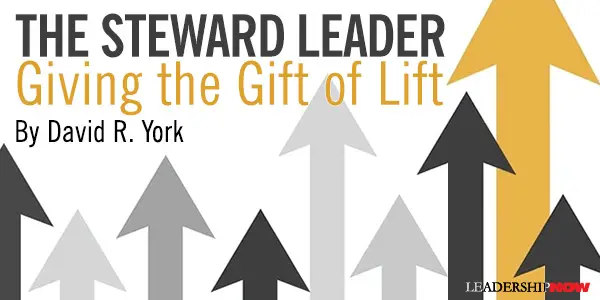
IN 2016, I was meeting with Gail Miller, one of the wealthiest women in the United States, as well as one of the most wise and generous. Gail was nearing completion of the transfer of her sole ownership in the Utah Jazz to a trust she had carefully designed to keep the team in Utah well into the future. During the course of reviewing various documents with her, I asked, “Gail, does it bother you at all to give away your ownership in the Jazz?” Gail looked up from the documents and said flatly, “I don’t own the Jazz.” Her response surprised me and gave me pause. “But you actually do own the Jazz,” I replied. I will never forget her response. “No. I don’t,” she reiterated, sitting back and looking me straight in the eye in a way that told me she knew exactly what she was saying and doing. “I’m a steward of the Jazz.” Her simple yet powerful reply has reverberated in my mind ever since and launched me on a journey researching, studying, and exploring the essence of stewardship and how it can be a transformative and freeing way to both live and lead. At their essence, stewards are women and men who are fully invested in something bigger than themselves. They combine both deep personal engagement with a bigger-than-them transcendent perspective that allows them to make lasting impacts in the lives of others. In the course of looking at Gail’s life and the lives of other stewards I studied, I came to identify four unique and powerful ways in which stewards lead in a fundamentally different way. 1. Stewards Use a Because/Therefore Model for Life. Because stewards have a clear knowledge of who they are, what they value, and what they believe, they are able to use a distinctive model for leading. Most of the non-steward world operates within an “if/then” mindset. In other words, if I do X, then Y will happen, or if I do A, then the world/others will do B. This mindset renders life mechanical, transactional, and outcome-based. In contrast, stewards lead with a “because/therefore” view of the world. This unique perspective makes life infinitely more relational, intentional, and transcendent. “Because” (transcendence) leads to “therefore” (deep personal investment). Their personal transcendence is the driver, and stewards are the agents, investing their energies in something bigger than themselves. The expectations are on the self, not on the outcome: because I value X, I expect myself to do Y. A because/therefore orientation also makes decision-making easier. As Roy Disney once said, “it’s easy to make decisions once you know what your values are.” 2. They Care More About Their Successors Than They Do Their Success. One of the most distinctive characteristics of steward leaders is their connection with the timeline of life. They see their role as a temporary one. This perspective makes them both forward-thinking and openhanded, allowing them to take on goals and projects they cannot accomplish alone or within their own lifetimes. Stewards aren’t concerned only with how their group or organization functions while they are alive and in charge; they look to the life of their business, family, organization, community, and even their country after they are gone. This perspective makes them intentional about how they allocate their time, talent, and treasure. It also makes them generous and openhanded when it comes to investing their resources and encouraging others to do the same. 3. They Are All About Purpose, Not Possessions. In the field of positive psychology, a major focus of research today is on the concept of purpose and how it affects the way we view and approach life. Researchers have come to the general consensus that purpose should be defined as follows: “Purpose is a stable and generalized intention to accomplish something that is at once personally meaningful and at the same time leads to productive engagement with some aspect of the world beyond the self.” As you may note, within this modern definition of purpose, we find both of the building blocks of stewards. Transcendence involves the focus on “some aspect of the world beyond the self,” and investment relates to the “intention to accomplish something,” which leads to “productive engagement.” Steward leaders know that, unless we are incredibly careful, what we own tends to own us back. Whether it’s our businesses, our homes, properties, all come at a cost. Stewards are unique because they aren’t held down by anything because they are owned by nothing but their purpose. This makes it much easier for them to sell assets, change positions, allow others to get credit, or even step down, as long as their overarching purpose is advanced. 4. Steward Leaders Don’t Seek Balance. They Seek Counterbalance. Counterbalances are used in a wide range of everyday devices, such as elevators, cranes, drawbridges, and even metronomes. The purpose of a counterbalance, or counterweight, is to provide a strong opposing force so that a machine can more effectively accomplish the task for which it is designed. Far from acting to limit or diffuse its opposing force, a counterbalance is meant to bring added strength, focus, and direction to the force it is countering. Steward leaders counterbalance transcendence (their why) with investment (their how) and allow the force of each to magnify the other. In addition, because stewards adopt the long-term perspective that goes along with taking on something bigger than themselves, their lives acquire a deliberate cadence, which allows them to move at a measured and intentional pace without burning out. Conclusion The path of the steward leader is both challenging and rewarding. It is, at the same time, both deeply personal and outwardly expressive. Those who embrace the way of the steward leader not only find the peace that comes from having a clear direction that comes from counterbalancing transcendence and investment, they also leave an indelible mark on the lives of their employees, friends, families, and communities—and on the world itself.  
Posted by Michael McKinney at 09:30 AM
11.03.22

Leading Thoughts for November 3, 2022
IDEAS shared have the power to expand perspectives, change thinking, and move lives. Here are two ideas for the curious mind to engage with: Political commentator Walter Lippmann claims that when the press exists primarily for its own purposes and agenda, it threatens democracy whenever it has an agenda other than the free flow of ideas: “We shall advance when we have learned humility; when we have learned to seek the truth, to reveal it and publish it; when we care more for that than for the privilege of arguing about ideas in a fog of uncertainty.” Source: Liberty and the News
Sociologist and educator David Stanley Eitzen on avoiding trends that deprive us of humanity: “Modern technology often encourages isolation. Because of computers and telecommunications, there is a growing trend for workers to work from home. At last count, 28 million Americans worked out of their homes, using computers or telephony instead of face-to-face interaction. While home-based work allows flexibility and independence not found in most jobs, these workers are separated from the rich social networks that often give rise to numerous friendships and make working life enjoyable or at least tolerable.” Source: Speech, “Avoiding Trends That Deprive Us of Humanity,” October 16, 2003 Look for these ideas every Thursday on the Leading Blog. Find more ideas on the LeadingThoughts index.
Posted by Michael McKinney at 07:09 AM
11.01.22

First Look: Leadership Books for November 2022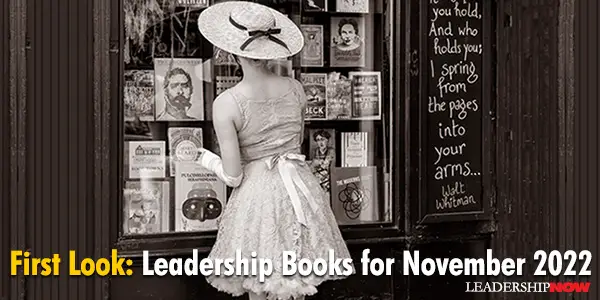
HERE'S A LOOK at some of the best leadership books to be released in November 2022 curated just for you. Be sure to check out the other great titles being offered this month.
If you took the economic might of Amazon, and added the penetration of Facebook, the ubiquity of Google, and the cultural significance of YouTube, you might have something starting to resemble Alibaba. Commonly mischaracterized as a kind of Chinese eBay for businesses, Alibaba and its interlinked network of products and services have exploded into global markets, disrupting conventional businesses and creating previously unimaginable opportunities for millions of small businesses worldwide. This book reveals the Tao of Alibaba—the company’s “secret sauce”—a consciously cultivated ethos and spirit that has enabled Alibaba to weather tough times and setbacks, and persist toward a common mission. It is a blueprint of the company’s management philosophy, crystalized into the most important elements that have driven its success, and it provides a road map for how to incorporate these principles into any organization’s operations.
Based on their research with thousands of executives from around the world, the authors share deep insights on how to implement smarter collaboration and avoid the potential pitfalls. They also help leaders troubleshoot thorny challenges like misaligned incentives, collaboration overload, and unintended consequences on diversity and inclusion. Complete with how-tos and cases, the book concludes with inspiring examples of groups harnessing smarter collaboration to tackle society's biggest challenges such as saving the oceans, eradicating diseases, and tackling global warming. Smarter Collaboration is the essential guide for forward-thinking leaders to transform their organizations, reshape the way they work, and increase impact and success.
In a masterful re-appraisal of a company that once claimed to “bring good things to life,” pre-eminent financial journalist William D. Cohan argues that the incredible story of GE’s rise and fall is not only a paragon, but also a prism through which we can better understand American capitalism. Beginning with its founding, innovations, and exponential growth through acquisitions and mergers, Cohan plumbs the depths of GE's storied management culture, its pioneering doctrine of shareholder value, and its seemingly hidden blind spots, to reveal that GE wasn't immune from the hubris and avoidable mistakes suffered by many other corporations. In Power Failure, Cohan punctures the myth of GE, exploring in a rich narrative how a once-great company wound up broken and in tatters—a cautionary tale for the ages.
Civility Rules! offers an opportunity to learn about the history, substance, and significance of civility through the lens of George Washington’s “Rules of Civility.” Drawing on personal experience, real-life examples, and a foundational belief that civility is integral to a democratic society, author Shelby Scarbrough shares how we might work toward a more perfect union by building a personal practice of civility. Civility is not an archaic concept of manners and politeness but rather a crucial component of a functioning democracy. Shelby shows us how―with conscientious practice and patience―we can each contribute to the preservation of our democracy, one interaction at a time.
This book will be your guide to avoiding the hazards of inflation while positioning your company to thrive when the business cycle stabilizes. It provides Ram’s down-to-earth recommendations and real-world examples to help you navigate a landscape that may be new to you. As you learn to lead through inflation, you will be better prepared for recession and stagflation as well. You will know how to protect your cash, your customers, and your capital investments. Your psychology will shift from anxiety and fear to optimism and excitement as you define the path to a reimagined future.
Burnout is among the most significant on-the-job hazards facing workers today. It is also among the most misunderstood. Citing a wealth of research data and drawing on illustrative anecdotes, The Burnout Challenge shows how organizations can change to promote sustainable productivity. Maslach and Leiter provide useful tools for identifying the signs of employee burnout, most often exhaustion, cynicism, and ineffectiveness. They also advise managers on assembling and interpreting worker self-evaluation surveys, which can reveal workplace problems and potential solutions. And when it comes to implementing change, Maslach and Leiter offer practical, evidence-driven guidance. The key, they argue, is to begin with less-taxing changes that employees nonetheless find meaningful, seeding the ground for more thorough reforms in the future.
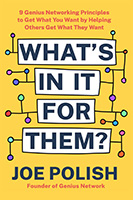 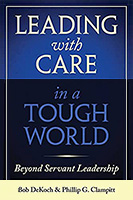 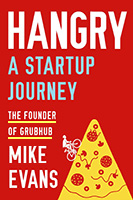 
“A library is not a luxury but one of the necessities of life.” — Henry Ward Beecher
Posted by Michael McKinney at 07:08 AM
|
BUILD YOUR KNOWLEDGE


How to Do Your Start-Up Right STRAIGHT TALK FOR START-UPS 
Grow Your Leadership Skills NEW AND UPCOMING LEADERSHIP BOOKS 
Leadership Minute BITE-SIZE CONCEPTS YOU CAN CHEW ON 
Classic Leadership Books BOOKS TO READ BEFORE YOU LEAD |
|